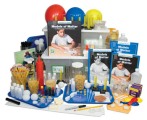Aquatic Ecosystems – A 40-Session Science and Literacy Unit
May 2, 2012 at 1:16 pm Leave a comment
Students learn about ecosystems, including the flow of energy and matter in ecosystems, and human impact on ecosystems. They also learn to make connections, pose questions, use text features as they read, and to write scientific descriptions. They learn and use scientific vocabulary, such as interact, decomposer, evidence, and hypothesis.

Investigations include:
1. Exploring Ecosystems
2. Conducting Ecosystem Investigations
3. Food Webs and Energy
4. Human Impact on Ecosystems
Investigation 1: Exploring Ecosystems
Students read Visit to a Pond and make connections between the text and posters of other ecosystems. They use Tabletop Pond Guide to set up the nonliving parts of their model ponds. They introduce Elodea, pond snails, then blackworms, Daphnia, and mosquitofish into their model ponds. They observe these pond organisms, record observations, and turn their notes into descriptive paragraphs. They use text features to locate information in Tabletop Pond Guide and generate questions to guide their reading of relevant sections. Students measure water clarity and temperature. They reflect on unit vocabulary and conduct a brief investigation with mosquitofish.
Investigation 2 – Conducting Ecosystem Investigations
Students observe and sketch dragonfly nymphs, add them to their model ponds, and write descriptive paragraphs about them. They read Investigating Crayfish and make connections. Each group chooses a question about dragonfly nymphs to investigate, then works to improve their questions. Students make hypotheses, plan their investigations, make data tables, and then conduct their investigations. After this, groups have the chance to change their setups to collect more data. They make bar graphs of the data they collected.They pose questions as they preview Dragonfly Explanations, then make connections as they read the book. Groups present their investigation findings to their classmates.
Investigation 3 – Food Webs and Energy
Students write descriptions of one interaction in their model ponds. They pose questions as they preview and then read Eat and Be Eaten: How an Ecologist Uses Food Webs. They create food webs , then make hypotheses about changes to ecosystems based on their food webs. Students make connections as they read What Makes Living Things Go? They discuss Energy Puzzlers, make energy pyramids, and do an energy flow simulation. Students read about and compare ecosystems in Ecosystems Around the World. They make a food-chain diagram based on data about organisms in one ecosystem poster.
Investigation 4 – Human Impact on Ecosystems
Students read Ecosystem News, make connections, and discuss how human impact can change ecosystems. They hold a discussion about whether or not they should release mosquitofish into a local aquatic ecosystem. Students investigate their schoolyard, collecting data about the environment and organisms. They write descriptions about their schoolyard ecosystem. They read Making a Difference and make all four types of reading connections. Groups research human impact and propose changes in the schoolyard to support more organisms. They create their final project – a labeled ecosystem diagram that they present to the class.
To learn more about the Aquatic Ecosystems Unit from Seeds of Science/Roots of Reading®, visit www.scienceandliteracy.org. You can also download a pdf version of the Aquatic Ecosystems Unit Overview detailing kit components, full book descriptions and a detailed Unit At-a-Glance Chart.
Aquatic Ecosystems features these nine student books:
Do you want to be notified when we publish new blog articles? Simply enter your email address in the “Follow Blog via Email” box located in the right sidebar.
Entry filed under: Seeds of Science / Roots of Reading Units. Tags: 4th grade science, 5th grade science, Aquatic Ecosystems, elementary curriculum, elementary lesson plans, elementary school science, elementary science, fifth grade science, fourth grade science, life science, science classroom, science teachers.















Trackback this post | Subscribe to the comments via RSS Feed